Yellow Warbler Wit II - July 2014
Belgian Wit, five-gallon batch, all-grain. We brewed a one-gallon version back in April, and we enjoyed it a lot. This five-gallon batch, however, contained a few tweaks. The recipe comes from the Brooklyn Brew Shop book titled Beer Making Book. Deb's research provided the tweaks.
Ingredients - Five Gallon
ABV is suppose to be 8.0%. - (Tweaks emphasized.)
- 8.0 lbs Belgian Pilsner malt
- 3.0 lbs Pale Wheat malt
- 1.5 lbs Caramel 10 malt
- 1.0 lbs Munich malt
- 0.35 oz Centennial hops
- 0.50 oz Tettnanger hops
- 1.0 oz Amarillo hops divided into halves
- 2 tablespoons of coriander seeds from the Deepam India market on Central Ave.
- 1.5 lbs Demerara unrefined sugar
- 2.3 oz of orange peel (we used Valencia oranges, something like that)
- 1 tablespoon of orange marmalade
- 1/4 teaspoon of Grains of Paradise
- Belgain ale yeast, Wyeast Belgian Strong Ale, 1388
- book recommends 1 cup of honey for bottling
- we used only 3/4 cup of honey because we wound up with only around four gallons of beer.
Deb crushed the coriander seeds and Grains of Paradise seeds before adding them to the boil.
Notes
- We brewed this beer on Sat, Jul 26, 2014 as part of Jerry's group beer brewing event called July Brewly. - Photos
- Deb and I arrived at Beer-Zero at 10:45 a.m.
- At 11:04 am, I set the kettle of four gallons of water onto the burner.
- At 11:15 a.m., I smacked the Wyeast packet. I should have done this at home earlier in the day. For some reason, this yeast packet failed to swell up much. It still had at least four hours to get excited before it was dumped into the fermenter, but it didn't do much. We may add more yeast within a few days of brewing.
- At 11:24 a.m., the mash process began.
- Unfortunately, we mashed at the low end of the desired temperature range. Our mash temp hovered between 140 to 143 degrees. Too low.
- Sparge water reached 170 degrees at 12:30 p.m.
- Deb began drawing off wort from the mash tun at 12:32 p.m.
- Done sparging at 1:32 p.m.
- According to Lou's refractometer, the pre boil gravity was 13 Brix.
- Boil began at 2:03 p.m.
- 60-minute boil.
- Post boil gravity was 17.2 Brix.
- Wort chilling began at 3:26 p.m.
- At 4:25 p.m., the wort temperature reached 72 degrees, so we stopped.
- We decided to leave all adjuncts in the wort. No filtering. So I dumped the wort from the kettle straight into the fermenter bucket. That aerated the wort adequately.
- We added the yeast and agitated the wort with a spoon back and forth to distribute the yeast.
- Bucket lid and air-lock added.
- By the next morning, Sun, Jul 27, the airlock bubbled well and constantly. No need yet for a blow-off tube.
- We need to decide on two things:
- whether to add more yeast
- move to a secondary and remove the adjuncts or leave everything in and ferment for two to three weeks only in the primary.
- On Sun, Jul 27, a bold, pleasant citrus smell emanated from the top of the air-lock, but we wondered if it's too strong with the citrus.
- The activity was good in the airlock, so on Mon, Jul 28, I switched to a blow-off tube. We did not add more yeast.
- As of Aug 5, it's still fermenting in the primary. -We won't move to a secondary.-
Secondary
On Mon, Aug 11, 2014, we moved the beer from the primary pale ale bucket into a the secondary glass carboy.
We did this to remove the adjuncts. We tasted some of the beer. It seemed a bit strong with the citrus flavor. Hopefully, it mellows in the secondary now that the adjuncts have been removed. It should mellow some once it has been bottled.
The secondary. Seems dark for a wit when it exists as a large volume.
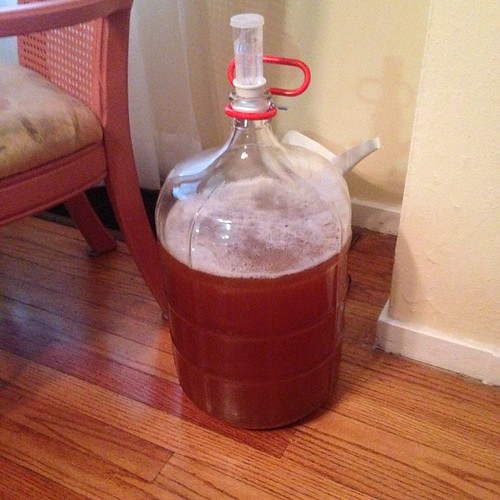
During the transfer from primary to secondary, we tasted some of the beer. It's cloudy like a wit should be. It looks more yellow in the glass, but it still seems darker than a normal wit. Maybe the sugar or the marmalade contributed to the darker color. No big deal if it tastes great.
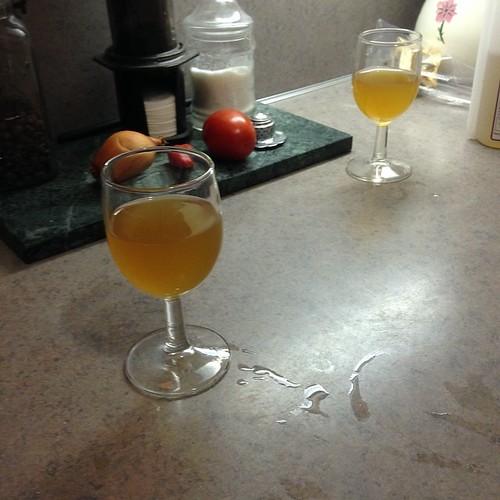
Bottling
We bottled on Thu, Aug 21, 2014. We tasted a small amount of leftover, and it had a strong taste.
We only managed to fill 40 bottles. We're doing something wrong, amount-wise. We left at least two bottles worth of beer in the secondary because it contained too much sediment.
Because of the lower amount of beer, we used about 3/4 cup of honey for bottling, instead of one cup.
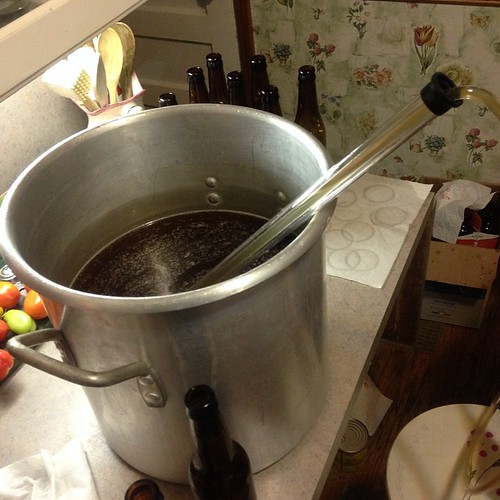
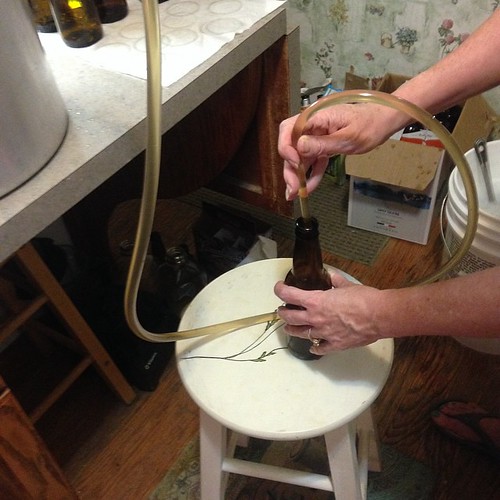
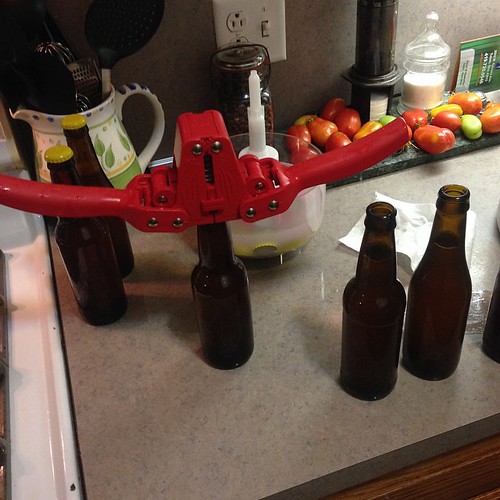
Tasting
Sep 1, 2014
We tasted the first bottle on Sep 1, 2014, and it was unpleasant. I think that it's too strong, alcohol-wise in a bad way, like it's some kind of medicine.
I noticed a little citrus odor, but I did not taste any citrus nor spice flavors.
This is not even close to the one gallon batch version that we brewed in the spring, which turned out well. It's so different that I would have thought they were two different beers.
Maybe additional aging will help, but I don't see how.
The problem is that it tasted off when we moved it from the primary to the secondary, and it tasted off on bottling day, and now it tasted off just shy of two weeks in the bottle. The chances that it will improve with age seem slim.
We were very pleased with our imperial stout at all the same stages, and it has improved with age.
Even if this version of the Belgian wit improves with age, I don't think that we'll keep it around for enough years for it to improve to drinkable status.
We'll try another bottle later this week. We'll give it a few weeks, and then we may need to dump it, so that we can use the bottles.
Oct 4, 2014
It tasted better. It must be mellowing out. This could be a good drink in a couple more months.
Dec 13, 2014
We decided to dump this entire beer. It still tasted off. And it was over-carbonated. Bad experience.
On the same day, we also dumped our five-gallon batch of the Belgian trippel because it tasted terrible too.
#Belgian - #wit - #5gal - #fruit - #spice - #group - #event - #photo - #dumped